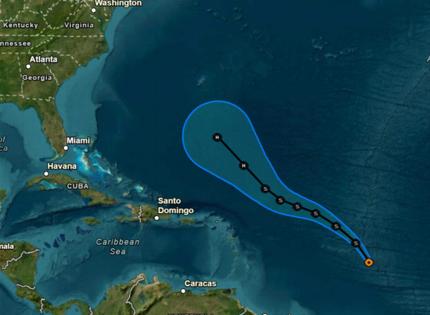Hurricane center says newly formed depression to become Tropical Storm Gabrielle
Published in News & Features
ORLANDO, Fla. — A new tropical depression formed Wednesday that is forecast to become Tropical Storm Gabrielle and strengthen further into a hurricane in the Atlantic, according to the National Hurricane Center.
As of the NHC’s 5 a.m. advisory, the center of what is now Tropical Depression Seven was located in the central Atlantic about 1,185 miles east-southeast of the Caribbean’s northern Leeward Islands with maximum sustained winds of 35 mph moving west at 13 mph.
“A west-northwestward to northwestward motion across the tropical and subtropical central Atlantic is expected during the next few days,” said NHC senior hurricane specialist John Cangialosi. “Slow strengthening is expected, and the system could become a tropical storm later today or tonight.”
Its forecast path keeps it away from land over the next five days.
“Only modest strengthening is expected over the next day or two as the depression continues to battle moderate shear from the aforementioned low aloft and intrusions of dry air,” Cangialosi said. “However, more notable strengthening seems likely by the weekend when the system moves into more conducive environmental conditions.”
Long-term projections has it growing into a Category 1 hurricane, which would be only the second hurricane of the season. It could then be a threat to Bermuda.
“The development of this system breaks a nearly 3-week streak of no tropical cyclones in the Atlantic basin during the peak of the hurricane season,” Cangialosi said.
The NHC also continued to track a tropical wave that emerged off the west coast of Africa on Tuesday. By 8 a.m. Wednesday, it was located just east and southeast of the Cape Verde Islands with an area of disorganized showers and thunderstorms.
“Environmental conditions are only marginally conducive, and any development of this system should be slow to occur while it moves westward at 15 to 20 mph across the eastern and central portion of the tropical Atlantic,” forecasters said.
The system is expected to bring heavy rain to the Cape Verde Islands through Thursday.
The NHC gave it a 10% chance to develop in the next two days, and 20% chance in the next seven days.
The next name after Gabrielle would be Humberto.
The climatological peak of the Atlantic hurricane season was on Sept. 10, but 60% of annual activity has historically happened after this date, the NHC stated.
With the new depression, the season has had only seven official storms. The most recent, Tropical Storm Fernand, petered out by the end of August.
The only hurricane had been Hurricane Erin, which grew into a massive Category 5 system with 160 mph winds but remained in the Atlantic without making landfall.
The National Oceanic and Atmospheric Administration in early August updated its season forecast to call for 13-18 named storms this year, of which five to nine would grow into hurricanes. Two to five of those would develop into major hurricanes of Category 3 or higher.
Hurricane season runs from June 1 to Nov. 30.
----------------
©2025 Orlando Sentinel. Visit at orlandosentinel.com. Distributed by Tribune Content Agency, LLC.







Comments